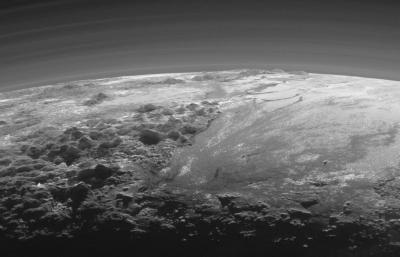
 Above: Pluto's mountains, photographed by the New Horizons spacecraft as the sun sets, 7/14/2015. Credit: NASA/Johns Hopkins University Applied Physics Laboratory/Southwest Research Institute
Above: Pluto's mountains, photographed by the New Horizons spacecraft as the sun sets, 7/14/2015. Credit: NASA/Johns Hopkins University Applied Physics Laboratory/Southwest Research InstituteIt’s been a big year for the late astronomer Percival Lowell. The New Horizons spacecraft is returning the first detailed images of Pluto, the dwarf planet whose existence he predicted, and for which he initiated a search which ultimately succeeded in 1930 (at the eponymous Lowell Observatory in Flagstaff, Arizona, thanks to Clyde Tombaugh’s careful observations).
And this week, NASA announced strong evidence of flowing liquid water on Mars. Lowell spent a lot of time and energy trying to chart what he believed were canals on Mars, evidence of a civilization on the planet. It turns out that he was wrong about canals, and pretty clearly wrong about a Martian civilization. But evidence of flowing water raises hopes that the planet hosts life.
It’s certainly true that life on Earth is dependent on water. Water has lots of handy chemical properties for life as we know it, which makes it likely that life elsewhere would also depend on (liquid) water. Finding liquid water on other planets would raise the odds of finding life as we know it elsewhere.
The qualifier “as we know it” carries a lot of weight in that analysis. How important water would be to any life on Mars (or elsewhere) is unclear, since we really only have one example of life—one big messy tree—to compare against. From what we know about the chemistry of life, it seems like water ought to be essential. By similar reasoning, carbon ought to be at the core of life on other planets. Once you have carbon chemistry and water, it’s likely that you’d wind up with a lipid bilayer containing proteins and nucleic acids for replication and metabolism. In other words, life as we know it (kinda).
Conveniently, many of those building blocks can be found in comets, and appear to be pretty easy to produce under the conditions that probably prevailed on Earth, Mars, and other planets (and some of the other moons in our solar system) in the solar system’s early days. Add in the observation that some of the earliest rocks on Earth that could plausibly contain evidence of life do indeed contain apparent microfossils and isotopic concentrations characteristic of biological metabolism, and it seems likely that life formed on Earth quite early. And if that’s true on Earth, why not Mars?
Even if life (somewhat like we know it) existed on Mars, there’s no guarantee it would still exist, let alone in any form we recognize. Earth’s surface was scoured by asteroid bombardment until about 3.8 billion years ago, then the surface nearly froze solid at least three times in a stretch between 850 million years ago and 635 million years ago. Any of those events could have wiped out life on Earth. Metazoan life was nearly obliterated in the waves of extinction around the Permian-Triassic border (other mass extinctions didn’t come quite as close, though they were pretty bad).
We know less about the geological history of Mars, but it’s surely a harsh environment today, and in the past it probably went through phases at least as bad as anything Earth experienced. Even if life had formed there, there’s no guarantee it would have survived. Mars seems to have been far less tectonically active, meaning that the refuges where life survived during eras of Snowball Earth may not have been available on Mars. It would also mean fewer of the energy-rich sites like hydrothermal vents where life probably started on Earth, making it less likely that life would survive or restart on Mars.
Or, at least, life as we know it. Even life based on water and carbon wouldn’t necessarily be easy to spot, or share the features we’re used to. One intriguing model for origin-of-life research draws heavily on iron-sulfur reactions for the early metabolic cycle of early life, using chemicals commonly found at hydrothermal vents (and which are notably common in the geology of Mars), and it doesn't have to be inside a cell. Robert Hazen, in his wonderful Genesis: The Scientific Quest for Life’s Origins, explains how that early life may not have been cellular at all:
The bold, heretical concept of flat life—a self-replicating chemical layer of molecules built on a solid mineral foundation—raises an intriguing geochemical possibility. A simple layered collection of molecules might be more tolerant of high temperatures and other environmental extremes than life based on nucleic acids, which break down close to 100ºC. If so, then colonies of flat life might exist today in deep zones of Earth’s crust. Such film-like molecular systems might persist for eons, because they survive at extreme conditions beyond the predation of more efficient cellular life.
If so, how would we know? Such a layer would be invisible under an ordinary light microscope and would appear as a nondescript film using more powerful atomic microscopes. Flat life would be undetectable in standard biological assays, which rely on the presence of DNA and proteins. Is it possible that layer life is abundant on Earth today, yet remains overlooked?
The idea that life-not-quite-as-we-know-it might still persist somewhere on Earth is fascinating enough. But more intriguing is the possibility that such life could exist on Mars. Many of the essential chemicals are common enough on Mars, and it seems likely that some version of the chemistry described by Hazen (drawing on Wächtershäuser’s work) could work on Mars, too. How reliant would such life be on water? How many assumptions that we usually make about what life needs would this chemistry force us to rethink?
All of this is a reminder of just how fundamental evolution is to our thinking about life. Life as we know it shares essential similarities thanks to its shared ancestry and to constraints inherent to chemistry, geology, and astronomy. When we look for life, we may well be focusing on the parts that owe to our common ancestry, and overlooking unfamiliar patterns. Percival Lowell was able to predict that something new was floating out past Neptune by understanding the constraints physics imposed on the Solar System (though, as it turns out, he based it on inaccurate information and basically got lucky). He was wrong about Martian canals because he saw what he wanted to see in the fuzzy and ambiguous surface markings of the planet. But it appears he was right that water flows on Mars, and we may yet find life there, if we can figure out how to see it.

